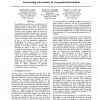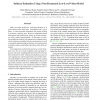954 search results - page 77 / 191 » Principles and Models for Organizing the IT Function |
IADIS
2003
13 years 9 months ago
2003
Despite numerous frameworks and models proposed in the literature, Information Systems (IS) assessment still remains elusive. Above all, there is little agreement on the contribut...
IJAR
2010
13 years 6 months ago
2010
Geospatial Reasoning has been an essential aspect of military planning since the invention of cartography. Although maps have always been a focal point for developing situational ...
INFFUS
2010
13 years 6 months ago
2010
This paper introduces design principles for modular Bayesian fusion systems which can (i) cope with large quantities of heterogeneous information and (ii) can adapt to changing co...
JMLR
2010
13 years 2 months ago
2010
Learning dynamic Bayesian network structures provides a principled mechanism for identifying conditional dependencies in time-series data. An important assumption of traditional D...
CVPR
2011
IEEE
13 years 4 months ago
2011
IEEE
Many successful models for predicting attention in a scene involve three main steps: convolution with a set of filters, a center-surround mechanism and spatial pooling to constru...


